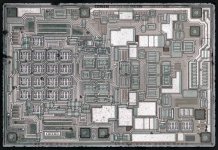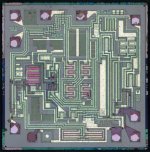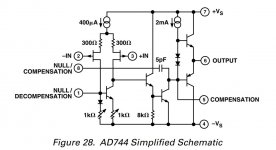I want to examine the sonic virtues (?) of an OPA627 for myself, however genuine OPA627's "seem" getting hard to find at less than $40 each from Digikey. To test the parts out what is the resistance between pin 5 and pin 7 of a genuine part? Pin 5 is normally one of the input terminals for an external offset trimmer (the other is pin 1 as ought to have the same resistance value). Both ought to be connected to the positive supply if the part is genuine.
Thus far alleged "genuine" parts have resistances connected to the negative rails, or appear on the wrong pins.
Thus far alleged "genuine" parts have resistances connected to the negative rails, or appear on the wrong pins.
If the goal is to examine the OPA627, and you do actually find one cheaper that meets your positive rail test, will you then be sure you have the real thing? No. If you want the real thing, pay the price and get it from a known reputable supplier. Mouser has the surface mount version in stock at $31.25 in single quantities, and an 8-pin DIP for $35.27.
Mike
Mike
Last edited:
Heh, let's talk about.
Opa627 fakes are taken from two types of crystals. Yes, they also JFET input opamps (if they wouldn't this will be very easy to check), but with a simpler in production crystals.
Say AD744, or something like ancient TL081.
They can even have trim pins and even fake makers could add needed resistances for pass this simple check.
But what's really differs such a JFET opamps from each other?
DC precision, input current/offset and widebandness!
So, it's much more easy to check.
Just wire an opamp with a gain of 10.000 times. It will have easily measurable output offset proportional to input offset/input current and easily measurable widebandness in extent of audioband.
So, just do this easy labour work and you're in.
Or just went to any good dentist office and ask to X-ray photo of chip, suppose it will have needed resolution, at least internal wire soldering points must be seen.
Original and two possible fakes are attached.


Opa627 fakes are taken from two types of crystals. Yes, they also JFET input opamps (if they wouldn't this will be very easy to check), but with a simpler in production crystals.
Say AD744, or something like ancient TL081.
They can even have trim pins and even fake makers could add needed resistances for pass this simple check.
But what's really differs such a JFET opamps from each other?
DC precision, input current/offset and widebandness!
So, it's much more easy to check.
Just wire an opamp with a gain of 10.000 times. It will have easily measurable output offset proportional to input offset/input current and easily measurable widebandness in extent of audioband.
So, just do this easy labour work and you're in.
Or just went to any good dentist office and ask to X-ray photo of chip, suppose it will have needed resolution, at least internal wire soldering points must be seen.
Original and two possible fakes are attached.



I suspect over 90% of OP627's wouldn't pass the most basic of physical measurements, this simply to take an Ohmmeter and measure from pin 5 to pin 7 (no powering up). The ones personally received seem more likely an NE5534 given the 12K Ohm measured value from pin 8 to pin 7, hence suspiciously not even a FET input. Most fakes must pass a functionality test, otherwise endless requests for return. Because offset trimming is rarely used the sellers can often get away with selling alternative fakes. If someone has the resistance value of a legitimate OP627 (as perhaps purchased from Digikey) this helps members verify their devices before being reported of variant sonic virtue in the diyaudio website. The question still remains what is the resistance value?
Last edited:
The question still remains what is the resistance value?
Pins 1-5 : 40-70 kOhm There are no precise value because it's fabricall laser trimmed based on different specs of the input JFET properties.
But it must be equal to sum of (1-7)+(7-5).
Last edited:
Pins 1-5 : 40-70 kOhm There are no precise value because it's fabricall laser trimmed based on different specs of the input JFET properties.
But it must be equal to sum of (1-7)+(7-5).
Thanks BesPav. Is it correct to conclude that you measured approx. 20-35 KOhm from pin (1 to 7) and pin (7 to 5)?
The bifet ad744 has the same resistance, is probably why they are rebadged and sold as opa627. By the way, they sound great, are probably fairly close to one another, guessing from the specs.
To get one from mouser or digikey, as already mentioned, is about the only way to know for sure.
To get one from mouser or digikey, as already mentioned, is about the only way to know for sure.
Thanks "phase"
The value of resistances could be similar, however the AD744 has the trimmer connected to the negative power supply rail, hence an ohmmeter could easily tell them apart with resistances being common to the opposite power supply rails.
Notwithstanding the quality of reproduction in the comparison to other amplifiers the internal topology of the OPA627 shows a cascode connected input that tracks the input from the input FET pair sources. This suggests a high degree of power supply rejection and low feedback capacitance on the input. Given its following by many in the diyAudio site this is why I am interested in it.
The value of resistances could be similar, however the AD744 has the trimmer connected to the negative power supply rail, hence an ohmmeter could easily tell them apart with resistances being common to the opposite power supply rails.
Notwithstanding the quality of reproduction in the comparison to other amplifiers the internal topology of the OPA627 shows a cascode connected input that tracks the input from the input FET pair sources. This suggests a high degree of power supply rejection and low feedback capacitance on the input. Given its following by many in the diyAudio site this is why I am interested in it.
I received a number of 2x single=>dual DIP-8 assemblies from China and the first thing I noticed was that the bottom/top sandwich didn't get that hot. Normally a 627 draws 7 - 7.5mA @+/- 15Vdc so x2 = ~15mA x 30V = ~1/2W. These drew exactly half the current so ran cooler. Otherwise, DC-wise they seemed OK.
Just another thing to check. Quiescent current draw.
Just another thing to check. Quiescent current draw.
Just another thing to check. Quiescent current draw.
Yes.
Say AD744 runs at about 3,5-4,5 mA.
Yes.
The first page of the pdf for the opa627 below shows the trimmer connections between pin 1 and pin 5 through resistors (probably equal value) to the +ve power supply. Interestingly I am currently sending a bunch back to Polida.
https://www.ti.com/lit/ds/symlink/opa627.pdf
The first page of the pdf for the opa627 below shows the trimmer connections between pin 1 and pin 5 through resistors (probably equal value) to the +ve power supply. Interestingly I am currently sending a bunch back to Polida.
https://www.ti.com/lit/ds/symlink/opa627.pdf
No. They have definitely different connections for triming.
Also AD744 trimming are referenced to a negative supply while OPA627 to a positive.View attachment 997778View attachment 997779
You are too quick for me BesPav
I am currently sending a bunch back to Polida.
Aaargh...
Well known fake supplier.
😀
I suppose many of the local postal services are in conspiracy with them. Just compare shipping cost to back.
My advice would be to use something like an NE5532, or a TL082 if you need a fet input, and work upwards from there.
The bigger issue here seems to be that people go for blazing fast op-amps, risking various kinds of oscillation, or they see 0.000001% "best case" distortion specs, and try to apply them to Sallen-Key filters with heavy capacitive loads and so on. Not to mention class-b distortion in the datasheet, when in actual use it may be biased into class a.
IM-not-so-H opinion if people can hear "night and day" differences in op-amps, allegedly because of ultra subtle 0.002 vs 0.0005 distortion specs, they're probably messing something up.
The bigger issue here seems to be that people go for blazing fast op-amps, risking various kinds of oscillation, or they see 0.000001% "best case" distortion specs, and try to apply them to Sallen-Key filters with heavy capacitive loads and so on. Not to mention class-b distortion in the datasheet, when in actual use it may be biased into class a.
IM-not-so-H opinion if people can hear "night and day" differences in op-amps, allegedly because of ultra subtle 0.002 vs 0.0005 distortion specs, they're probably messing something up.
My advice would be to use something like an NE5532, or a TL082 if you need a fet input, and work upwards from there.
Oh, please, no.
Those are overcompensated opamps and NE5532 even not a FET one.
OP was asking how to measure an op-amp to figure out if it really is what it says it is.
I'm saying that if they don't have this knowledge, they should not be using such op-amps in the first place.
I'm saying that if they don't have this knowledge, they should not be using such op-amps in the first place.
- Home
- Amplifiers
- Solid State
- OPA627 question

